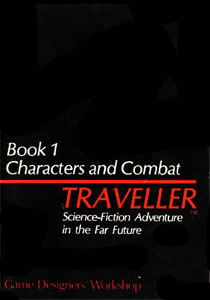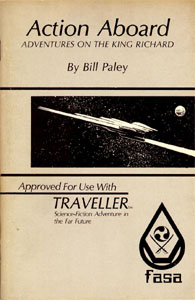 As a brief tangent to our discussion of game structures, how could we go about plugging the “hole” in Traveller’s scenario structure?
As a brief tangent to our discussion of game structures, how could we go about plugging the “hole” in Traveller’s scenario structure?
Since Traveller’s starmaps are hex-based, we could start by rifling through the pockets of the hexcrawl and snagging the concept of “when the PCs enter the hex, trigger the hex’s keyed content”. But what we’ll quickly realize is that there’s a reason Traveller doesn’t do this already: Planets are really, really big.
If we think of a dungeon room or a wilderness hex as a “container” which holds keyed content, it’s pretty easy to recognize that a planet-sized container completely dwarfs the scale of any single encounter or location. Take an encounter and stick it in a dungeon room; it fills the room. Take the same encounter and put it in a wilderness hex; it gets a little bit lonely but there’s still enough to quench our thirst. Stick it on a planet, on the other hand, and the glass still looks completely empty.
And this isn’t just a matter of aesthetics. It impacts the GM’s ability to logically transition the scene: If the PCs are traveling through a wilderness, it’s relatively easy to find a transition from the macro-level of wilderness travel to the micro-level of the keyed encounter. You just say something like, “As you pass through the forest, you see a bunch of orcs.” But this method doesn’t work quite as well if the PCs are approaching a planet.
Perhaps more importantly, this also affects the ability for players to make meaningful decisions within the context of the scenario structure. If the GM of a hexcrawl says, “You see a castle perched upon a rocky crag of blackened stone.” The players can say, “Okay, that looks scary. I think we’ll just skirt it as far to the west as possible.” And they can do that. But if they were to say, in this hypothetical game structure for spacecrawling, “Okay, I don’t want to deal with this settlement of murderous cannibals. Let’s lift-off and land somewhere else on the planet.” Suddenly they’ve exited the purview of the scenario structure.
One logical leap from this conclusion is that we simply need to key more content to the planet. Maybe, for example, we could just map the entire planet and key it as a hexcrawl: Thus, just like a hexcrawl contains dungeoncrawls, our spacecrawl would contain hexcrawls.
But hexmapping and keying an entire planet in any sort of meaningful or interesting detail? That’s an absurd amount of work. It’s obviously completely impractical.
HAILING FREQUENCIES OPEN
So maybe, instead of that, we let our logic take us the other way. Maybe we accept our limitations and implement a structure where each planet is keyed with a “hail”: When an intrepid band of interstellar scouts enters orbit, they’ll receive the hail.
This basically handles the problem of scale by embracing the old pulp SF trope of “every planet is a village”. The result is less Traveller: Firefly and more Traveller: Star Trek. But as long as the players are onboard with the fact that they have to either engage with Oxymyx and Krako or bypass the planet (i.e., they can’t just decide to head over to the other side of the planet and talk to a different set of gangsters), you’ll probably be in pretty good shape.
Unfortunately, the structure starts to breakdown once you’re dealing with civilized planets (instead of exploration). But, of course, this is also true for traditional hexcrawls (which provide no guidance for PCs once they pass through the gates of Greyhawk).
ABOARD THE KING ARTHUR
Unsurprisingly, I’m not the first person to start thinking this way about Traveller. Back in 1981, FASA produced Action Aboard: Adventures on the King Richard. In addition to detailing the ISCV King Richard and providing two sample adventures, this module included a dozen or so “Outline Adventures”, all of which constitute primitive scenario structures into which any number of specific scenarios could be poured. For example, the Hijack:
The forcible capture of the vessel and its contents may come from either inside or outside the ship.
A) Internal
A hijack from inside assumes that the hijackers and their equipment are all aboard at the beginning of the scenario.
1) Players as crew – the players may or may not be issued weapons from the ship’s locker, depending upon the level of surprise.
2) Players as passengers – The players will not be given weapons and, unless they have social standing A-F, they will be abandoned at any habitable planet (roll 1-4 on one die) or shot, and/or dumped into a vacuum (roll 5 or 6 on one die). If they have high social ranking, they will be ransomed.
And so forth.
Primitive? Yes. Still incomplete? Sure. But you can see how this begins to provide a basic structure into which a few stats can be poured to give you something that can be used in play. In combination with the other “Outline Adventures”, Action Aboard begins to give you enough structure to run an entire campaign based around the voyages of the ISCV King Arthur.














I guess there’s also a middle-way solution: starships can’t just land anywhere because they’re too fragile/this damages their handwavium/whatever. They either have to dock on orbit (making this a single-entry point), or have shuttles land on specially prepared landing pads (which still makes this a bit easier to plan than “they can land anywhere”).
I think a good substitute for the hex’s keyed content would be embellishing the system’s library data. Of course, for most systems in Traveller’s published setting (or in a newly created subsector), there not a lot of data already out there. The GM has to be prepared to make a lot up ahead of time.
The World Builder’s Handbook from Digest Group Publications was an awesome resource for this sort of thing. There was even a bit of software to automate the information in it. I used it to come up with some interesting setting information that I used to describe the system as the PCs’ ship came out of jumpspace.
@3Jane – Under Traveller’s worldgen, it’s actually illegal to land anywhere but the starport on a lot of worlds. Even where it is legal, it’s suspicious; it screams “We’re smugglers and don’t want to go through customs.” So you can get away with two prepped encounters – one at the starport, and the other with customs agents. It does get tricky for those real backwaters where there’s no law whatsoever, but wilderness random encounter tables seem to work there; while I am unwilling to map entire planets, rolling up a handful of random beasties (maybe 3-4) per planet of interest is a reasonable amount of prep for a world without much civilization. So the PCs end up choosing between starport and random animals.
When I ran Traveller inspired games, most of my planet-side encounters took place in the starport. The few times a starport wasn’t involved, there was always a specific point of interest. But also at that time, I wasn’t running a keyed sandbox.
If I was keying a Traveller sandbox, I would key up a variety of encounters at likely points of interest. Planet doesn’t have a starport, but has lakes or seas for re-fueling? Make the key somewhat flexible, have encounters keyed up for a few possible points and unless the players make specific requests for landing points, just put the encounter at the place they land.
Consider also that most times, unless the ship is just stopping by like we might pull over at a highway scenic viewpoint, there is a commitment to a certain time frame.
And accept that sometimes the best way to deal with the encounter is to bail out and refuel or whatever someplace else. How many times have you pulled into a gas station or restaurant, seen some issue (long lines, cleanliness, rude staff), and got back in the car and went down the street to the next place. Nothing wrong with that, just plan to allow that in your encounter key (also, this is no different than dungeoneers bursting through a door and then deciding to bail out and try the next door [or smarter, listening at the door]).
Frank
“But hexmapping and keying an entire planet in any sort of meaningful or interesting detail? That’s an absurd amount of work. It’s obviously completely impractical.”
You know how in a hex crawl you don’t guarantee that a keyed encounter will be met because a hex is so big? This is the same really. A planet could be mapped as 20 triangles (20 sided dice shape). Each triangle has random encounters at least, and 0, 1 or 2 major points of interest. The points of interest can be a town, star port, city or significant location, or it could be an area that contains a hex crawl that covers some part of the containing triangle. So you have some nested scales : planet triangle, hex crawl, urban/dungeon/location crawl. It should not be necessary to fill everything up with the lowest scale stuff. The trick is scale transition, which is a problem you have discussed before.
Done a lot more playing since my last blog.
Here is my structure:
There are factions of people/aliens and some will be present here from other systems. There are also local factions. These tend to represent forces that give rise to “interesting situations” because of their nature and agenda. The planet itself, at any point, can randomly have some stuff that is generally typical of the planet or a region of it, but also faction stuff and faction conflict. Where the players go and what they encounter, or places they find out about from afar, begin to solidify as detail.
Prep, as such, is more detailed the closer you get to where the players are. And where the players have been leaves patches of deeper detail behind that can be revisited later and fleshed out even further.
I did an interesting experiment using the character development system on some NPCs to build a very interesting part of my campaign. I create rich star systems but I rarely map them to any detail. That just materialises ahead of the PCs. Its the broad scale context that guides the process.
https://www.rpggeek.com/thread/1667115/free-terran-confederation-s3-gm-prep-experiment